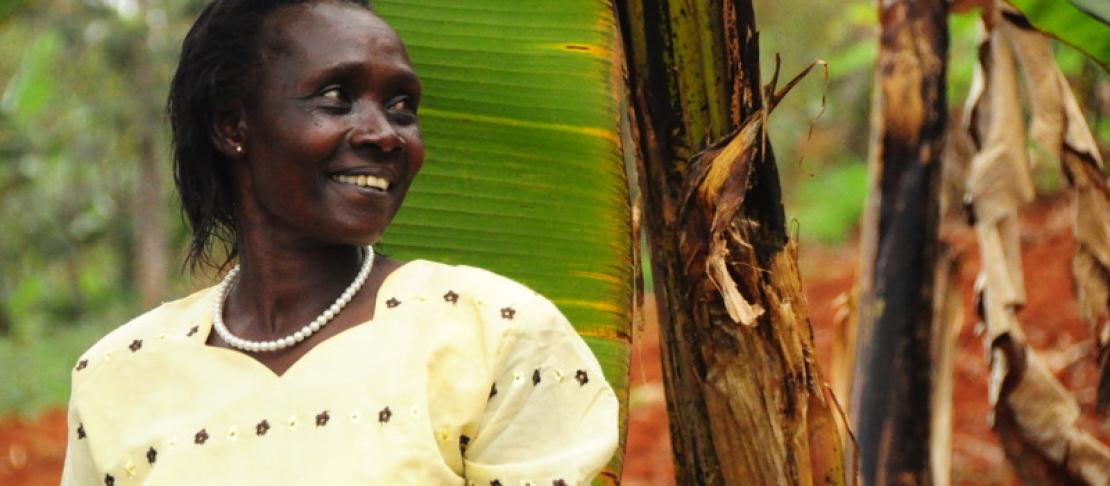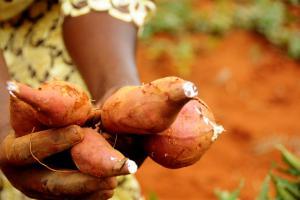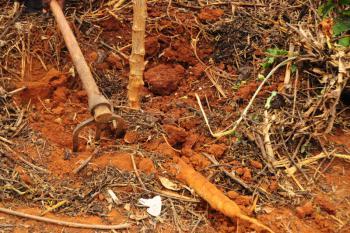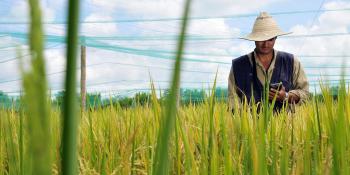Climate change adaptation: What we can learn from Emily Marigu, a farmer in Kenya

Anyone doubting the effect of climate change, and how farmers can adapt continuously to changing weather patterns, should talk to Emily Marigu Ireri.
We met Emily, near Meru, eastern Kenya, where she farms a five acres plot, 1,500 meters high on the steep slopes of Mount Kenya.
She describes how, in recent years, the rains are more erratic. At the beginning of the rainy season, often it would only rain for a few days, and then stop, sometimes for weeks. “Often seeds would start to sprout during those first rains, but then they would dry up”, Emily explains. She takes us to the bottom of the valley just below her fields. “By this time of the year, this small stream would normally be a river, but now, it hardly irrigates the fields around it. A few miles from here, the river is dead, water is just absorbed by the soil.”
“But it is not only the erratic rains that makes the life of farmers difficult“, Emily explains. “Here, so close to Mount Kenya, we also used to get misty drizzle in May and June. From the time of my father’s fathers, we used that moisture for a crop in the middle of the year. Now that drizzle does not come anymore. I don’t know why, but nowadays, we can only get one harvest a year, in the rainy season. Now is the time for the rain to come."
As we walk up the hill again, Emily stops and grabs a handful of dry soil “A few drops we had, some days ago, and it stopped again. Often when it starts again, the rains are very short, but come in heavy downpours. It washes away the fertilizer, the manure and erodes my top soil. Unless if I stop this erosion, soon I would be left with unfertile land.” She stops for a moment, as she brushes over the top of the tea bushes: “That is true for most of these changes the weather brings: Unless if I change too, I will no longer be able to provide for my family”.
Without using the big words, Emily is adapting to climate change. She is eager to share her experiences to help other farmers. That is why she wanted to talk to us: “Show what we have learned here”, Emily smiles, “we have found new ways. Ways others can use too!”. While a bit timid at the beginning, her enthusiasm was clear.
Diversification of crops
"Maize and beans were mainly what we used to grow. Combined with a field of coffee and tea to sell, and we were ok. But now, neither maize nor beans do well anymore. Since the weather changed, there is also a pest that affects our maize crop. I still plant some, but far less than before”.
 “Root crops that is what people should grow”, she says with a finger in the air, “Cassava, potatoes and sweet potatoes. They do much better, as they are more tolerant to spells of drought… Look at my shamba, here!“ She points out the several varieties of sweet potatoes, some that grow faster than others, from two to six months. This way they plant over a longer period, but can also harvest longer. The different varieties need water at different times, so they spread their dependency on the rains to come at a specific time. If one variety fails, they can also fall back onto another.
“Root crops that is what people should grow”, she says with a finger in the air, “Cassava, potatoes and sweet potatoes. They do much better, as they are more tolerant to spells of drought… Look at my shamba, here!“ She points out the several varieties of sweet potatoes, some that grow faster than others, from two to six months. This way they plant over a longer period, but can also harvest longer. The different varieties need water at different times, so they spread their dependency on the rains to come at a specific time. If one variety fails, they can also fall back onto another.
One variety of cassava that grows over a duration of six month, seems to does very well now. To prove her point, she digs out the roots of one cassava. She shows me huge tubers one foot long, the biggest cassava root I have ever seen.
Mulching
As we walk up the hill, in between the different crops, she makes a sign “Come here,” she says, and shows us a field which is covered with dead leaves. “A dead crop?” I ask, but she laughs and shakes her head.. “We use the leaves, leftover from other crops, to cover the potato plants. In English they call it “mulching”. The dead leaves help the soil retain moisture, reduce erosion, provide nutrients, and suppress weed growth and stimulate seed germination. She lifts some of the dead leaves to show tiny shoots of sweet potato.
Erosion
With the rains now coming in more violent squalls, Emily protects her soil more than ever before. Mulching is one way, but she also keeps the tea bushes at the bottom of her field. She shows me how the density of the stems keeps the soil from running down into the river. “It is also a way to keep the manure from running off”, Emily smiles, “but I have learned that bananas like the strong rains, so I planted more green bananas for baking and yellow bananas to sell on the market”.
Irrigation
When asked “how about irrigation?” she laughs. “Not much water left in the river,” she says, “It takes a lot of investment for piping and pumps to get it up the hill to her fields. But even then, I would drain the river, and those people downstream would not have any anymore”.
Community farming
“Now also, we organise us in groups”, Emily explains. “We rent a piece of community land, and work together with other farmers. This is important, as while we tend the field, we talk of the crops, and we exchange ways to grow other crops. Different people find different solutions, so we help each other. They tell me of solutions they have found, and I share my experiences. That is how we survive”.
Watch Emily speak about her story
The Climate Change, Agriculture and Food Security programme (CCAFS) is learning how farmers are adapting to climate change in different parts of the world, in order to enhance research on managing immediate climate risks, and on longer-term adaptation to progressive climate change. Photos in this article by Peter Casier.



